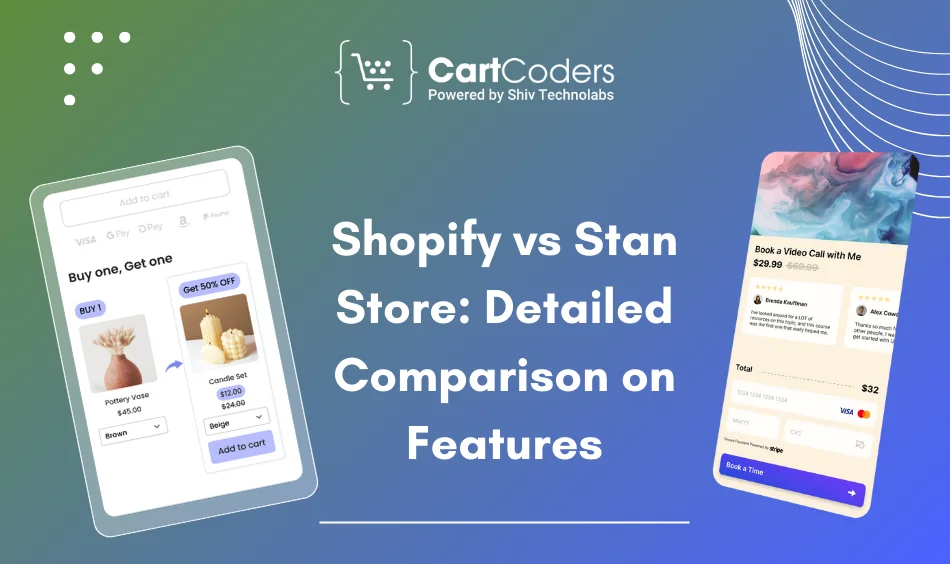Custom Engagement Solutions
Unlock tailored solutions with a free, no-obligation strategy session.
Expert Developers & Engineers on Demand
Scale Your Team with Skilled IT Professionals
Expert Guidance for Digital Transformation

The e-commerce environment provides several ways for business owners to develop their profiles. Speaking of the most popular sites to make a purchase or sell online, Stan Store vs Shopify are among the most popular ecommerce platforms at the moment. Stan Store is on its way to becoming a platform for creators focusing on simplicity and cost, while Shopify has been known for being a package to meet all the needs of any type of company.
This post will describe these platforms, including their features, costs, advantages, and disadvantages, to help you decide which platform is most appropriate for your business.

Shopify is a good platform that has enabled over a million companies to develop an online store. In a uniquely defined ecosystem, it offers a great deal of analytics, inventory management, payment solutions, and variant templates. Shopify is designed for any type of business and is suitable for those who have just started their companies and large enterprises.
As it has been mentioned, Stan Store is quite a young player in the scene. It is aimed at small businesspersons, freelancers, and artists who seek a hassle-free method of making a sale from their products, services, or creations. With over 50% of GMV originating from digital downloads priced between $4 and $30, Stan has helped producers create over $100M in total sales volume as of April 2024.

The table below compares the key features of Shopify and Stan Store to help you understand their core differences.
| Feature | Shopify | Stan Store |
| Ease of Use | Beginner-friendly but with a learning curve for advanced features. | Extremely intuitive and built for creators with minimal technical expertise. |
| Customization | Fully customizable with access to code (HTML, CSS, Liquid templates). | Limited customization; relies on predefined templates. |
| eCommerce Tools | Comprehensive tools for inventory management, SEO, abandoned cart recovery, and more. | Basic tools geared towards selling digital products and services. |
| Payment Options | Over 100 gateways, including PayPal, Stripe, and Shopify Payments. | Limited options; primarily integrates with Stripe. |
| Mobile Optimization | Fully responsive templates and a dedicated mobile app for store management. | Responsive designs, but lacks a dedicated app. |
| Third-Party Integrations | Thousands of apps are available via the Shopify App Store for added functionality. | Limited third-party integrations; supports only basic apps. |
| Scalability | Highly scalable for growing businesses with multi-channel sales and global reach. | Designed for small-scale operations; not ideal for growth-focused companies. |
| Support | 24/7 support via chat, email, and phone. | Limited support options, primarily email-based assistance |
Although Shopify has a clear dashboard and user-friendly layout, its sophisticated capabilities may require some understanding. Shopify’s customising features provide unmatched adaptability for companies with developers or sophisticated demands.
Stan Store, however, is designed for simplicity. Those with little to no technological knowledge may quickly establish a working shopfront in a few hours.
With access to its Liquid template engine and CSS/HTML code, Shopify lets customers design their shop almost entirely. This makes it perfect for companies with a distinctive, branded internet presence.
Stan Store is more limited in this regard; it offers pre-made designs ideal for designers but lacks the depth required for significant branding or uniqueness.
Features like inventory control, abandoned cart recovery, extensive reporting, and strong SEO skills define Shopify’s toolkit as unparalleled. These instruments serve companies offering both physical and digital goods.
Stan Store specializes in memberships, digital items, or services sold by artists. Its simple toolkit does not fit companies with complicated physical commodities or inventory requirements.
Shopify supports over 100 payment channels, guaranteeing flexibility for multinational companies. Additionally, providing Shopify Payments helps lower transaction costs.
The Stan Store mostly depends on Stripe, so it is not very useful for companies looking for many choices of payments.
Offering multi-channel selling, worldwide currency support, and sophisticated analytics for operational scalability, Shopify can expand with your company.
The Stan Store is less perfect for companies with long-term expansion ambitions; it is better suited for small-scale firms and individual entrepreneurs.
Stan Store vs Shopify Pricing regarding distinct markets. The Stan Store keeps things basic with a single plan; Shopify has a tiered price structure.
Every Shopify plan comes with extra transaction fees unless Shopify Payments is utilized, which costs 2.9% + 30¢ per transaction.
One plan calls for $29 a month.
Stan Store’s single-price approach covers all of its capabilities, which makes it more straightforward but less adaptable for companies that could need more tools as they grow.
Shopify: Pros
Shopify: Cons
Stan Store: Pros
Stan Store: Cons
Your company model and objectives will primarily determine which of Shopify and Stan Store you should use.
If you want a strong, scalable platform with sophisticated tools and customising choices to run an expanding eCommerce business, go to Shopify. If you are a solopreneur or artist seeking a quick, reasonably priced way to market digital goods or services, use Stan Store. CartCoders is the best Shopify development company offering top-notch development services to give the upper hand to your online store.
Our team of developers excels at developing stores that make all the difference, impressing your customers in one go. Our area of expertise at CartCoders is enabling companies to create and maximize Shopify shops tailored to their specific requirements. Contact us today to get the best-in-class Shopify development services.
Projects delivered in 15+ industries.
95% retention rate, building lasting partnerships.
Serving clients across 25+ countries.
60+ pros | 10+ years of experience.